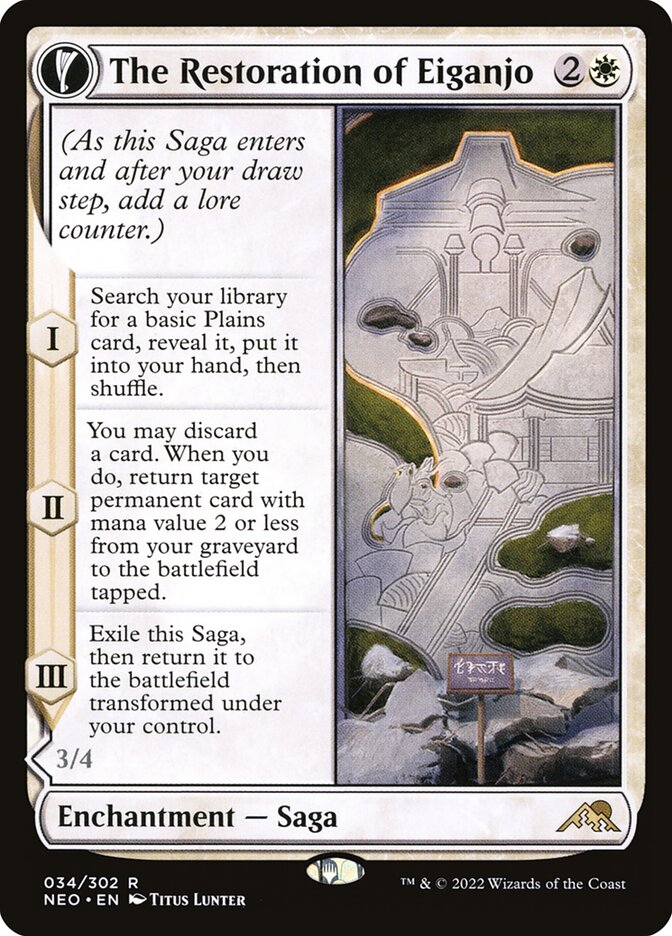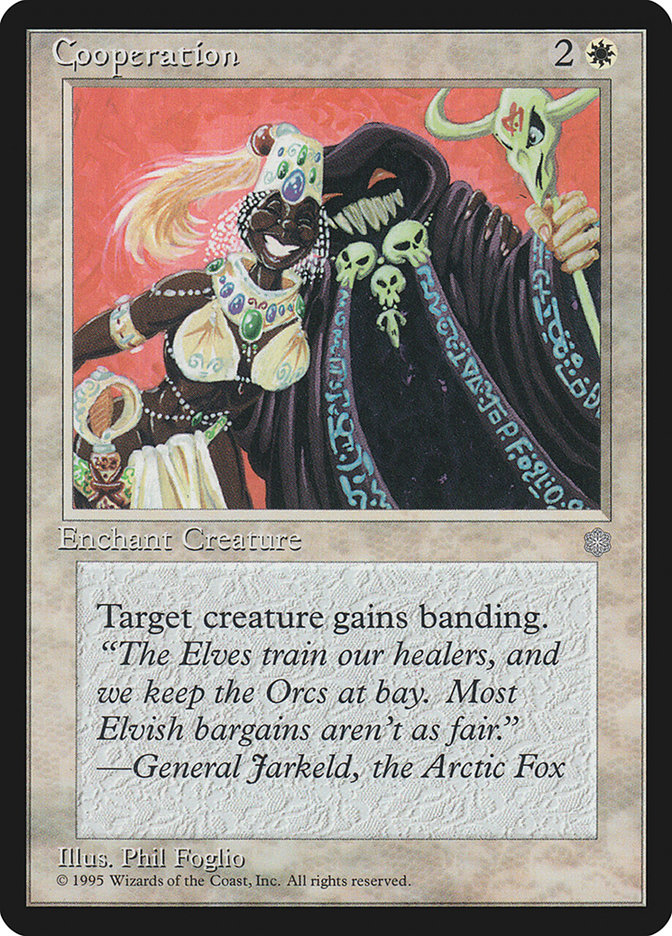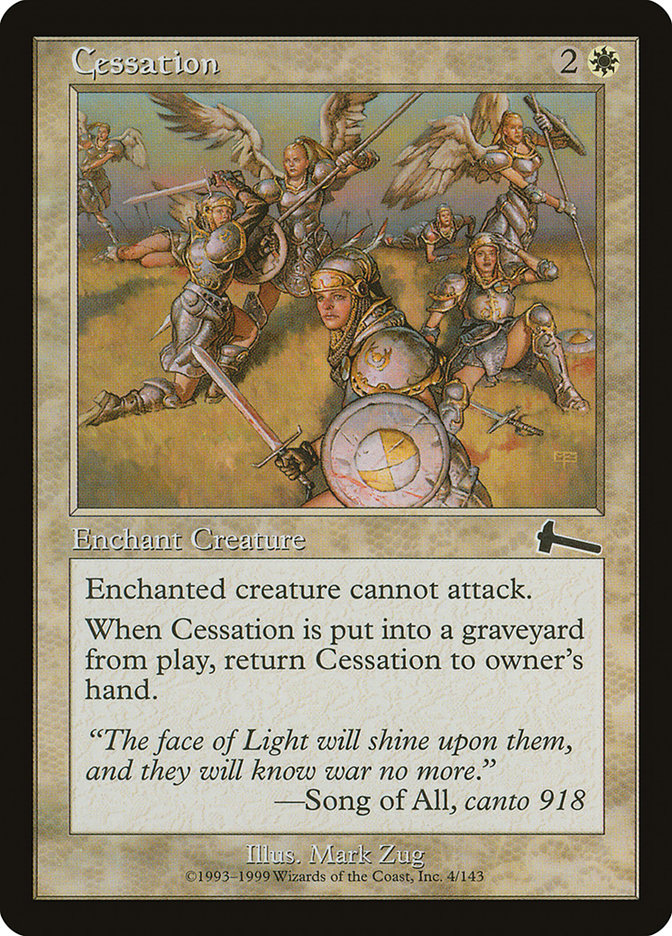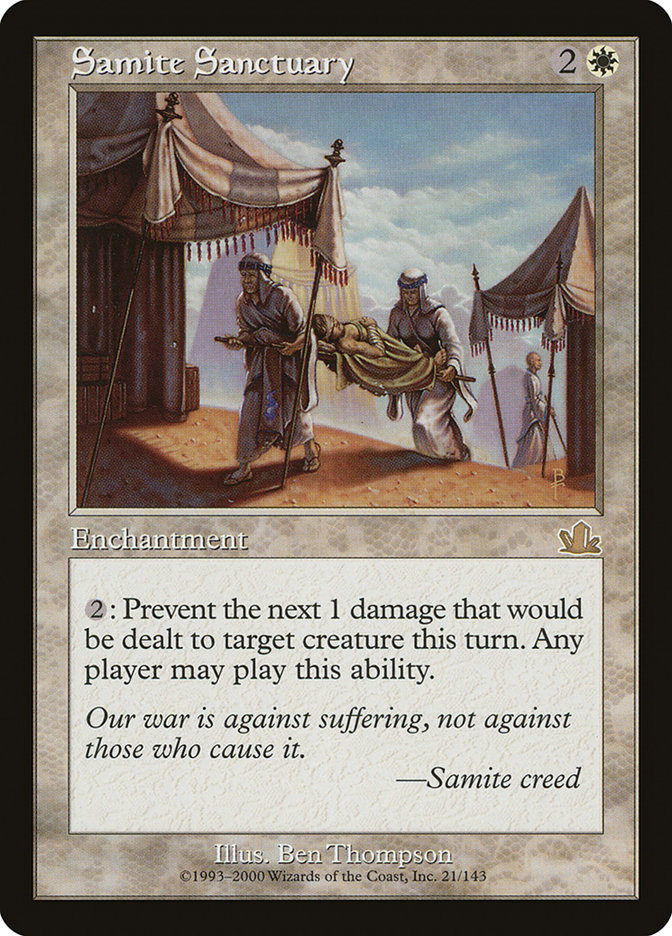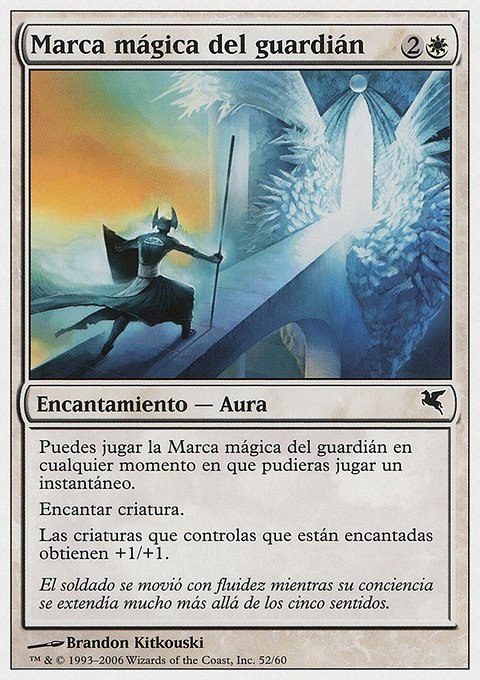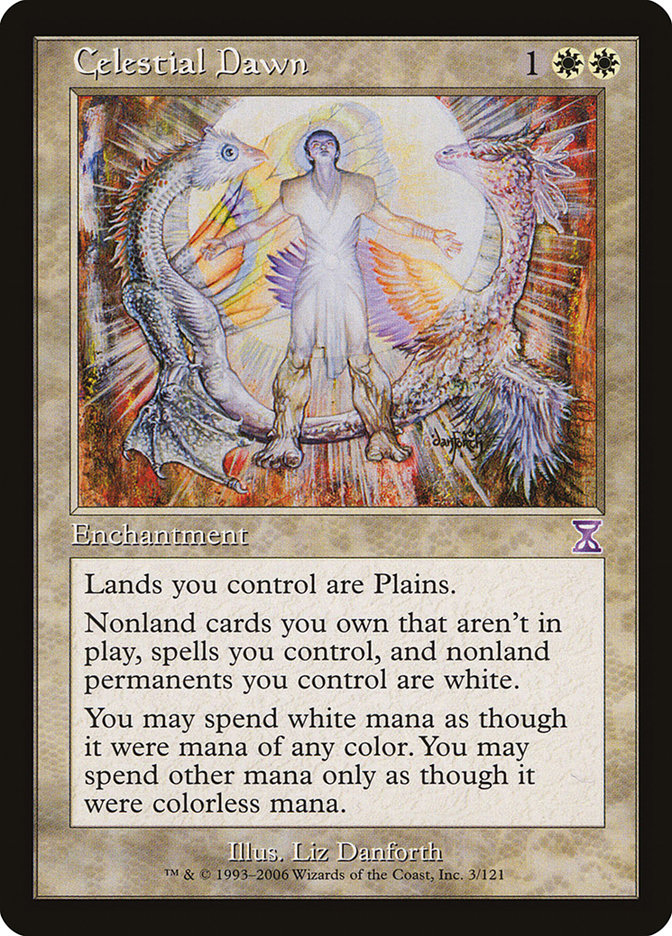The Restoration of Eiganjo // Architect of Restoration MTG Card
| Card sets | Released in 5 setsSee all |
| Mana cost | |
| Converted mana cost | 3 |
| Rarity | Rare |
| Type | Enchantment — Saga |
| Abilities | Transform |
Text of card
(As this Saga enters and after your draw step, add a lore counter.) I — Search your library for a basic Plains card, reveal it, put it into your hand, then shuffle. II — You may discard a card. When you do, return target permanent card with mana value 2 or less from your graveyard to the battlefield tapped. III — Exile this Saga, then return it to the battlefield transformed under your control.
Cards like The Restoration of Eiganjo // Architect of Restoration
The Restoration of Eiganjo is a noteworthy embodiment of a white enchantment in Magic: The Gathering that incorporates both land recovery and token creation. Resembling Oath of Lieges, it enables players to return lands from the graveyard to the battlefield. However, Oath of Lieges, unlike The Restoration of Eiganjo, aids all players which can be less advantageous in a competitive setting.
Another parallel can be drawn with Emeria, The Sky Ruin, which also capitalizes on the activation of abilities from the graveyard. Emeria requires a significant setup, reviving creatures during your upkeep, but only triggers if you control seven or more Plains, a feature The Restoration of Eiganjo does not share. Instead, The Restoration provides a steady flow of enchantment-based value without such a stringent land requirement.
Lastly, Kjeldoran Outpost stands as a relative, although it necessitates the sacrifice of a Plains to create tokens. The Restoration of Eiganjo avoids this sacrifice by creating Spirit creature tokens once a certain threshold of exchanged life is met, thereby maintaining land count without compromise.
Players valuing resilience and gradually increasing battlefield presence will appreciate The Restoration of Eiganjo’s blend of consistent land retrieval and token generation, a synergy well-suited for long-term tactical advantage.
Cards similar to The Restoration of Eiganjo // Architect of Restoration by color, type and mana cost
Card Pros
Card Advantage: The Restoration of Eiganjo provides a recurring method of advantage by allowing you to return a creature card from your graveyard to your hand at each of your upkeeps. This consistent mechanism makes sure that you never run out of creatures to play, effectively giving you an edge over your opponent as the game progresses.
Resource Acceleration: By recovering creature cards, this enchantment indirectly contributes to resource acceleration. Returned creatures, especially those with mana abilities, could potentially be played again, offering you additional opportunities for mana production or other valuable actions during your turns.
Instant Speed: The enchantment operates at the pace of the game’s natural progression, providing its benefits at the beginning of each of your upkeeps. While not at instant speed, its recurring effect can be as valuable as an instant, as it doesn’t require additional mana investment each turn to regain assets, leaving your mana open for other immediate responses.
Card Cons
Discard Requirement: The Restoration of Eiganjo demands players to discard a card to capitalize on its full potential. This stipulation means players must be mindful of their hand size, as depleting valuable cards to activate its abilities could hinder their overall game strategy, especially in tight situations where card advantage is crucial.
Specific Mana Cost: The card comes with a precise mana cost that requires white mana. This condition may restrict the card’s inclusion only to those decks that can consistently produce white mana or have a mana base specifically tuned to accommodate such costs, thereby reducing its versatility across various deck archetypes.
Comparatively High Mana Cost: When it comes to utilizing your mana efficiently, The Restoration of Eiganjo falls on the expensive side, demanding a significant amount of mana which could be allocated to other spells with immediate board impact. Players must weigh its long-term benefits against the possibility of losing tempo in the earlier turns of a match.
Reasons to Include The Restoration of Eiganjo in Your Collection
Versatility: The Restoration of Eiganjo shines in its flexibility, slotting effortlessly into white-based control or midrange decks. As a land that transforms into a utility spell, it provides a dual role—ensuring you aren’t starved for mana early game, while offering a strategic advantage in the later stages.
Combo Potential: For those who enjoy synergistic plays, this card can be a gem. Its ability to bring back powerful legendary creatures from the graveyard not only serves as a recursion strategy but also synergizes well with decks focused on legendary mechanics or grave-based interactions.
Meta-Relevance: In an environment where legendary creatures are pivotal, having The Restoration of Eiganjo in your arsenal ensures that your key pieces return to the battlefield. It’s a smart addition for those seeking to maintain presence and resilience against removal-heavy decks.
How to beat
The Restoration of Eiganjo is a card that poses a curious challenge for players in Magic: The Gathering. Known for turning the tides in a game, this dynamic card shifts landscapes and brings permanents back into play. When pitted against this card, one should consider its potential to transform into the Legendary Land – Eiganjo, Seat of the Empire, and the implications it has for board presence.
To effectively counterplay, consider cards with land destruction capabilities or ones that thwart abilities upon activation. Direct removal spells could be insufficient since Restoration can activate from the graveyard. Hence, utilizing graveyard hate could prove beneficial. Rest in Peace or Leyline of the Void can prevent such graveyard interactions, crippling your opponent’s ability to capitalize on the Restoration’s duality. Additionally, employing counterspells when the enchantment is played ensures that this formidable card does not hit the board, denying your opponent the chance to gain its advantages.
Bearing in mind that every setting differs and each deck has its unique strategy, the key lies in understanding The Restoration of Eiganjo’s strengths and intercepting them before they unfold. A mindful approach and the right intervention can dismantle its influence, keeping the scales of battle in your favor.
BurnMana Recommendations
The Restoration of Eiganjo embodies adaptability and perseverance in MTG, proving itself as an essential for white-centric decks. Its unique capabilities to recur creatures provides you with a persistent edge, tipping the scales in protracted duels. For those looking to refine their tactics and outlast opponents, this card offers a pathway to success. Remember, the game is about long-term strategy as much as immediate victories. Enhancing your deck with robust, well-rounded cards like The Restoration of Eiganjo is instrumental in curating a winning strategy. Dive deeper with us and discover the competitive edge you’ve been seeking in your MTG journey.
Where to buy
If you're looking to purchase The Restoration of Eiganjo // Architect of Restoration MTG card by a specific set like Magic Online Promos and Kamigawa: Neon Dynasty, there are several reliable options to consider. One of the primary sources is your local game store, where you can often find booster packs, individual cards, and preconstructed decks from current and some past sets. They often offer the added benefit of a community where you can trade with other players.
For a broader inventory, particularly of older sets, online marketplaces like TCGPlayer, Card Kingdom and Card Market offer extensive selections and allow you to search for cards from specific sets. Larger e-commerce platforms like eBay and Amazon also have listings from various sellers, which can be a good place to look for sealed product and rare finds.
Additionally, Magic’s official site often has a store locator and retailer lists for finding Wizards of the Coast licensed products. Remember to check for authenticity and the condition of the cards when purchasing, especially from individual sellers on larger marketplaces.
Below is a list of some store websites where you can buy the The Restoration of Eiganjo // Architect of Restoration and other MTG cards:
 BUY NOW
BUY NOW BurnMana is an official partner of TCGPlayer
- eBay
- Card Kingdom
- Card Market
- Star City Games
- CoolStuffInc
- MTG Mint Card
- Hareruya
- Troll and Toad
- ABU Games
- Card Hoarder Magic Online
- MTGO Traders Magic Online
See MTG Products
Printings
The The Restoration of Eiganjo // Architect of Restoration Magic the Gathering card was released in 3 different sets between 2022-02-18 and 2022-02-18. Illustrated by 2 different artists.
| # | Released | Name | Code | Symbol | Number | Frame | Layout | Border | Artist |
|---|---|---|---|---|---|---|---|---|---|
| 1 | Magic Online Promos | PRM | 97897 | 2015 | Transform | Black | Titus Lunter | ||
| 2 | 2022-02-18 | Kamigawa: Neon Dynasty | NEO | 34 | 2015 | Transform | Black | Titus Lunter | |
| 3 | 2022-02-18 | Kamigawa: Neon Dynasty | NEO | 354 | 2015 | Transform | Black | yo-ne | |
| 4 | 2022-02-18 | Kamigawa: Neon Dynasty | NEO | 442 | 2015 | Transform | Black | Titus Lunter | |
| 5 | 2022-02-18 | Kamigawa: Neon Dynasty Promos | PNEO | 34s | 2015 | Transform | Black | Titus Lunter |
Legalities
Magic the Gathering formats where The Restoration of Eiganjo // Architect of Restoration has restrictions
| Format | Legality |
|---|---|
| Standard | Legal |
| Historicbrawl | Legal |
| Historic | Legal |
| Legacy | Legal |
| Oathbreaker | Legal |
| Gladiator | Legal |
| Pioneer | Legal |
| Commander | Legal |
| Modern | Legal |
| Future | Legal |
| Vintage | Legal |
| Duel | Legal |
| Explorer | Legal |
| Brawl | Legal |
| Timeless | Legal |
Rules and information
The reference guide for Magic: The Gathering The Restoration of Eiganjo // Architect of Restoration card rulings provides official rulings, any errata issued, as well as a record of all the functional modifications that have occurred.
| Date | Text |
|---|---|
| 2022-02-18 | A transforming double-faced card enters the battlefield with its front face up by default, unless a spell or ability instructs you to put it onto the battlefield transformed or you cast it transformed, in which case it enters with its back face up. |
| 2022-02-18 | Each face of a transforming double-faced card has its own set of characteristics: name, types, subtypes, abilities, and so on. While a transforming double-faced permanent is on the battlefield, consider only the characteristics of the face that's currently up. The other set of characteristics is ignored. |
| 2022-02-18 | Each transforming double-faced card in this set is cast face up. In every zone other than the battlefield, consider only the characteristics of its front face. If it is on the battlefield, consider only the characteristics of the face that's up; the other face's characteristics are ignored. |
| 2022-02-18 | If you are instructed to put a card that isn't a double-faced card onto the battlefield transformed, it will not enter the battlefield at all. In that case, it stays in the zone it was previously in. For example, if a single-faced card is a copy of Azusa's Many Journeys, the chapter III ability will cause it to be exiled and then remain in exile. |
| 2022-02-18 | If you choose to discard a card as The Restoration of Eiganjo's second chapter ability resolves, a second triggered ability goes on the stack and you choose a target for it. Notably, this means you may target the card you discarded if it is a permanent card with mana value 2 or less. |
| 2022-02-18 | The back face of a transforming double-faced card usually has a color indicator that defines its color. |
| 2022-02-18 | The mana value of a transforming double-faced card is the mana value of its front face, no matter which face is up. |
